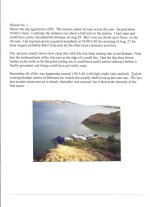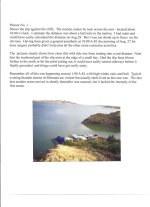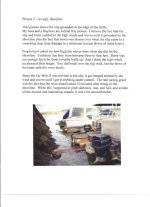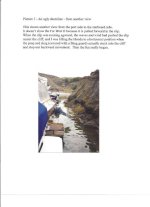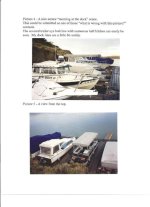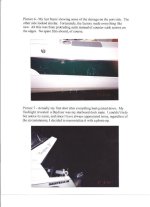Following the old cliche about a picture being worth a thousand words, Sea Coast Joe has been a huge help. I was able to scan the seven photos which I took at the scene of the crash and email them to him. Joe has already put one on his album site. Go to that to see the photos and captions.
The pictures will replace your imagination. Once the adventure was over, I did some introspection about my prepardness to deal with an emergency. I did not achieve a high score. In fact, I did a number of things wrong before the slip hit the shore line. Only the fact that (1) the slip hit the most favorable area of the cliffs to slam against and (2) the storm quickly abated after the slip was against the cliffs kept me and the Far West II from being in a worse situation.
Here is my analysis. Being robbed of one's senses can cause considerable confusion. Awakened from near exhaustion, unable to see anything during the worst of it, trying to interpret all the sounds, and making good decisions is easier said than done.
I had been pushing myself for some time. I could have postponed the knee surgery but that was scheduled in June of 1997 before my personal life began to uinravel. Just turning 62 meant I was no spring chicken.
The mind plays tricks on us. I was not the physical specimen I thought I was. Having experienced a heart attack in August of 1994 was one wake
up call. But a rigorous fitness program thereafter gave me a false sense of security.
Since I had been at the Hell Creek Marina many times before, I knew the topography very well. The cliffs were no stranger to me. Immediately, when I became aware the slip was blowing backwards, I understood it "could go all the way."
Turning on the VHF was a complete waste of time. The marina office was vacated at that time. Besides, nothing could be done for me anyway.
Getting the radar working was OK, but I didn't monitor it to calculate the distance to the opposite shore line.
I didn't turn on my GPS which would have given the speed of drift.
When I decided to start the engine, considerable time had already passed and dropping the engine, squeezing the bulb, all took precious seconds.
But my worst mistake was fiddling with the bow, mid, and aft cleat lines.
I had mentioned in an earlier comment, that a friend had borrowed the boat in early August. He had run a line from the cleat on the slip to the eye bolt, which is hard to reach from the hatch - almost impossible - and it had numerous half hitches as did the mid and aft lines. I was trying to save the mooring lines when time was of the essence. Very foolish of me.
When I decided to cut loose, I made a poor choice. The aft and mid lines were cut first. I tried to stand on the side walkway, but it was buckling and the wind was howling. Getting back in the boat was now timing the "jump", and my foot slipped off the gunwale causing my hurt knee to get abused. I had to open the hatch, climb out and slither on my belly to get my shoulders and head over the edge to reach down and cut the rope.
Fortuinately, I had a knife that was up to the task. The hatch stood up to the wind pressure but of course the wind driven rain poured in while I was cutting away. In the morning the aisle had a half inch of water standing in it, all which came in through the hatch.
Quickly scrambling back through the hatch, and getting it closed against the force of the wind - which took some effort - and at last, I was able to back out of the slip.
But as I mentiioned earlier, to my horror, the lightning flash revealed I was already at the cliff line without not enough space and time to back out and get away from the slip. I made the only decision I could and took the Honda out of reverse and and put it in forward. In a few seconds the slip grounded at the cliff shoreline, and now I had some new problems.
The waves were now coming over the slip, and I had no secure ropes on the Far West II. I mention in an earlier post how the waves push the boat backwards, and how I had lifted the engine, turned it off and how it had impaled the cliff.
I managed to get one line on the dock and the mid cleat and the boat stopped thrashing around. A couple of fenders on the side helped ease things.
Picture 6 shows the damage when the boat was untied. I made the mistake of not leaving the fenders on before I cut the ropes.
After things had quieted down, and before the second storm came in, I took the picture of "Imagine It," and then decided to go ashore. That too was a mistake. I didn't take an abandon ship bag ashore. I really didn't have one made up although all the essentials were aboard.
Once the second storm came in and lightning began to crackle all around, I decided the soaked shoreline was a poor place to sit, so I had to get back in the boat and put on dry clothes. The night stayed very warm.
It was a very long day!

